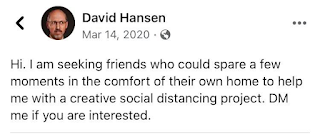 |
| Queenie in "The Wild Party" (Art Spiegelman) |
My wife and I had separated, half of the furniture in the house we had purchased a little over year before was gone with her, and I had recently been diagnosed with a hernia for which I would receive surgery the following month. I was serving pizzas in an Uno’s in Lyndhurst, I had no theatrical prospects at all. I was twenty-six.
The train was comfortable, and warm, unless I leaned close to the window, which was frosted. The northeast was in a cold snap, NYC that week would be the coldest I have ever experienced. Still on the train, I opened my new laptop (with the last of the black and white screens) and began to write a play about vampires.
My girlfriend worked at the Shakespeare & Company at 81st and Broadway, the one featured in When Harry Met Sally (“Someone is staring at you in Personal Growth”) and while she was on I browsed and read and even bought, or walked around the corner to Café Lalo to sit and sip and write.
One book I picked up at that time was a recently released hardcover edition of the poem The Wild Party by Joseph Moncure March, and illustrated by Art Spiegelman (Maus). I’m not sure what caught my eye about it. Maybe it was Spiegelman. Maybe it was the claim that the poem was “lost”. Maybe it was the 20s. Maybe it was my 20s.
At that time I had only a passing interest in the 1920s, though it was piqued that week as we saw the Alan Rudolph film Mrs. Parker and the Vicious Circle at some little theater in the East Fifties which surely doesn’t exist any more. At that time I was into generational theory and turned onto the idea that the Lost Generation and that generation we call “X” had much in common. Aimless, rootless, artistic, unbound, nihilistic, you know … “whatever.”
 |
| Mrs. Parker & the Vicious Circle |
Mrs. Parker is a biopic, starring the incomparable Jennifer Jason Leigh, and it was easy to overlook her personal disappointments and misery when she and Robert Benchley (Campbell Scott) were writing away at facing typewriters, creating threadbare stage performances, or trading witticisms in the Algonquin.
We could do all of this, though standing in the smoldering remains of Guerrilla Theater Co. I no longer knew who “we” were.
The Wild Party is told in rhyming, irregular couplets, March’s meter is what makes the piece sing, the timing of the rhymes is irreverent, in places obscene, always funny, and very funny. And the subject is so sordid! A showgirl named Queenie and a clown with a violent temper named Burrs decide to throw a wild party, and that’s really it.
There is drink, there is dance. There is an orgy. A teenager is assaulted, and the fighting begins. Burrs discovers Queenie having sex with another man, things go tragic. Then the cops arrive, the end.
Spiegelman doesn’t get in the way of the narrative, just promotes it with his graphic imagery. It has a hard-boiled quality, like Chester Gould’s Dick Tracy. Handsome guys have square jaws, Burrs is long and narrow like a villain. I do question why there is so much female nudity, but only female nudity.
The 1920s were transgressive, folks were pushing back against their hopelessness with wildness and pleasure. The 90s were hardly hard times for us, but I certainly felt a little lost.
The Wild Party is told in rhyming, irregular couplets, March’s meter is what makes the piece sing, the timing of the rhymes is irreverent, in places obscene, always funny, and very funny. And the subject is so sordid! A showgirl named Queenie and a clown with a violent temper named Burrs decide to throw a wild party, and that’s really it.
There is drink, there is dance. There is an orgy. A teenager is assaulted, and the fighting begins. Burrs discovers Queenie having sex with another man, things go tragic. Then the cops arrive, the end.
Spiegelman doesn’t get in the way of the narrative, just promotes it with his graphic imagery. It has a hard-boiled quality, like Chester Gould’s Dick Tracy. Handsome guys have square jaws, Burrs is long and narrow like a villain. I do question why there is so much female nudity, but only female nudity.
 |
| The Secret Adversary (A Tommy & Tuppence Adventure) |
I began casting about everywhere for inspiration, though it wasn’t until my two Agatha Christie adaptations, nearly twenty years later, that I took the opportunity to focus on the 20s. Tommy and Tuppence, however, are far too sweet and hopeful, especially as compared to the jaded Queenie and Burrs.
In 1995, I channeled my nihilistic tendencies into the contemporary milieu of a vampire-themed coffee bar.





